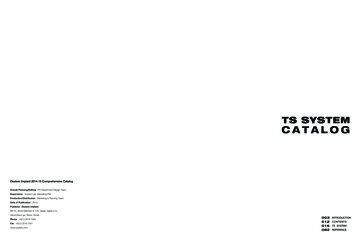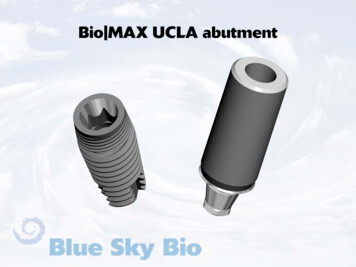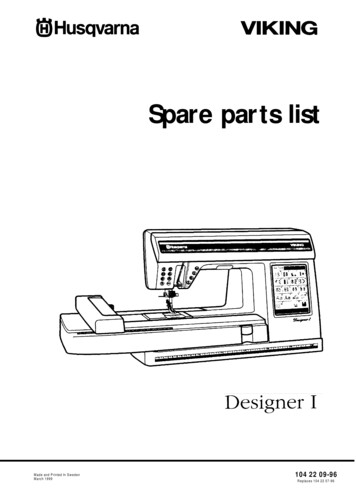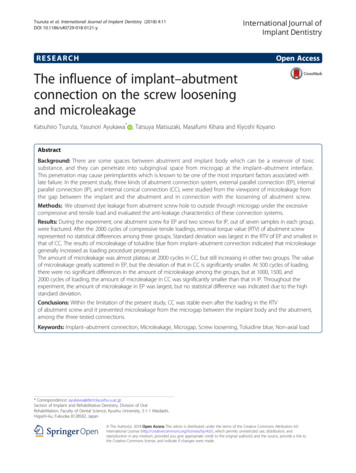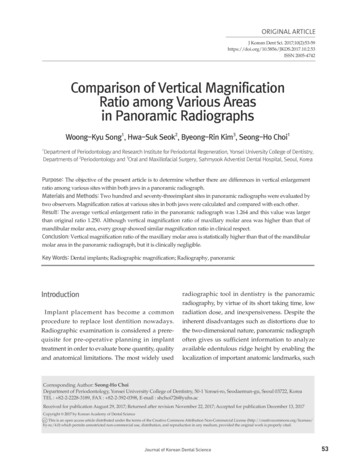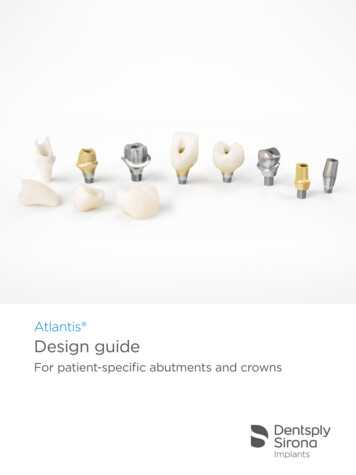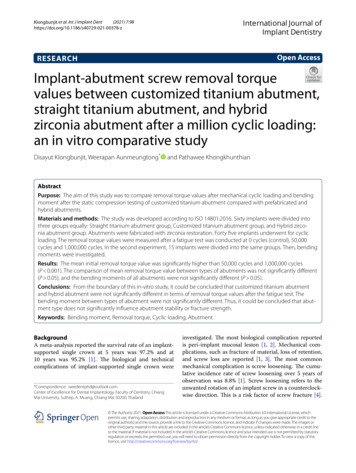
Transcription
International Journal ofImplant Dentistry(2021) 7:98Klongbunjit et al. Int J Implant Denthttps://doi.org/10.1186/s40729-021-00378-zOpen AccessRESEARCHImplant‑abutment screw removal torquevalues between customized titanium abutment,straight titanium abutment, and hybridzirconia abutment after a million cyclic loading:an in vitro comparative studyDisayut Klongbunjit, Weerapan Aunmeungtong*and Pathawee KhongkhunthianAbstractPurpose: The aim of this study was to compare removal torque values after mechanical cyclic loading and bendingmoment after the static compression testing of customized titanium abutment compared with prefabricated andhybrid abutments.Materials and methods: The study was developed according to ISO 14801:2016. Sixty implants were divided intothree groups equally: Straight titanium abutment group, Customized titanium abutment group, and Hybrid zirconia abutment group. Abutments were fabricated with zirconia restoration. Forty five implants underwent for cyclicloading. The removal torque values were measured after a fatigue test was conducted at 0 cycles (control), 50,000cycles and 1,000,000 cycles. In the second experiment, 15 implants were divided into the same groups. Then, bendingmoments were investigated.Results: The mean initial removal torque value was significantly higher than 50,000 cycles and 1,000,000 cycles(P 0.001). The comparison of mean removal torque value between types of abutments was not significantly different(P 0.05), and the bending moments of all abutments were not significantly different (P 0.05).Conclusions: From the boundary of this in-vitro study, it could be concluded that customized titanium abutmentand hybrid abutment were not significantly different in terms of removal torque values after the fatigue test. Thebending moment between types of abutment were not significantly different. Thus, it could be concluded that abutment type does not significantly influence abutment stability or fracture strength.Keywords: Bending moment, Removal torque, Cyclic loading, AbutmentBackgroundA meta-analysis reported the survival rate of an implantsupported single crown at 5 years was 97.2% and at10 years was 95.2% [1]. The biological and technicalcomplications of implant-supported single crown were*Correspondence: weedentphd@outlook.comCenter of Excellence for Dental Implantology, Faculty of Dentistry, ChiangMai University, Suthep, A. Muang, Chiang Mai 50200, Thailandinvestigated. The most biological complication reportedis peri-implant mucosal lesion [1, 2]. Mechanical complications, such as fracture of material, loss of retention,and screw loss are reported [1, 3]. The most commonmechanical complication is screw loosening. The cumulative incidence rate of screw loosening over 5 years ofobservation was 8.8% [1]. Screw loosening refers to theunwanted rotation of an implant screw in a counterclockwise direction. This is a risk factor of screw fracture [4]. The Author(s) 2021. Open Access This article is licensed under a Creative Commons Attribution 4.0 International License, whichpermits use, sharing, adaptation, distribution and reproduction in any medium or format, as long as you give appropriate credit to theoriginal author(s) and the source, provide a link to the Creative Commons licence, and indicate if changes were made. The images orother third party material in this article are included in the article’s Creative Commons licence, unless indicated otherwise in a credit lineto the material. If material is not included in the article’s Creative Commons licence and your intended use is not permitted by statutoryregulation or exceeds the permitted use, you will need to obtain permission directly from the copyright holder. To view a copy of thislicence, visit http://creativecommons.org/licenses/by/4.0/.
Klongbunjit et al. Int J Implant Dent(2021) 7:98Screw loosening may result from excessive bite forcesand non-functional loading [5].The mechanism of an abutment screw to retain anabutment and fixture together depends on the mechanical properties of the screw. When a screw is tightened, itelongates and generates force, which is called “clampingforce”. The force results from the elastic recovery of screwmaterial. Tightening force is called “preload”. Decreasedseparating force and increased clamping force stabilizethe abutment connection and prevent screw loosening[6]. The settling effect is preload loss in 2–3 min to 15 hafter screw tightening without any external force intervention [7]. The settling effect could influence preloadloss by 2–10% [5]. Siamos et al. recommended a protocolto prevent the settling effect, suggesting that the screwshould be retightened 10 min after first-load application[8].When the external load is beyond the preload, abutment-screw connection loses stability, affecting thevibration and micromovement of the interfaces, whichcauses screw loosening [5]. Huang et al. summarized thevarious factors that affect abutment-screw loosening inimplant-retained prostheses. Abutment geometry andthe manufacturing method influence the stability of theimplant-screw connection [7]. El-Sheikh et al. reportedthat expanding the angulation and length of the collar increases the risk of screw loosening. The length ofan abutment functions as a vertical cantilever, whichgives bending force to the implant screw by the principle of levers [9]. Taper contact design makes friction-lockmechanism, retention results from the frictional resistance through a Morse taper design, which also stabilizesthe connection [10]. Abutment fabrication influences theincidence of screw loosening. Kano et al. reported thata machined abutment has less incidence of torque losscompared with a cast abutment [11]. This screw joint stability results from the smaller gap between the abutmentand fixture interface compared with a machined abutment [12]. Recently, some abutments use an anodizedtechnique to colour abutments. However, this procedure influences abutment stability, which is significantlyreduced by about 20% removal torque [13].The implant abutment could be classified accordingto implant-abutment connection, abutment material,retention with prosthesis, and method of fabrication[14]. According to manufacture criteria, abutments areclassified into customized abutment and prefabricated(stock) abutment [14, 15]. Most prefabricated abutmentsare made from titanium. Manufacturers offer them instraight and angled types. However, to achieve goodemergence profile and aesthetics, dentists should placethe implant in a precise position and angulation [15].Customized abutments provide an individual emergencePage 2 of 9profile. A dentist can position the margin of a crownaccording to the location of the soft tissue margin [14].Computer-aided design/computer-assisted manufacture(CAD/CAM) technology is applied for manufacturingcustomized abutments [16]. Customized titanium abutments with CAD/CAM technology are suggested as thestandard choice due to their high clinical success ratesand less corrosion than a universal castable long abutment (UCLA abutment) [17]. However, the grey colourof a titanium abutment shines through in thin soft tissueareas, and a customized titanium abutment selection isan aesthetic risk option [18]. To minimize the metal colour of titanium abutments, a zirconia framework is useddue to its aesthetic qualities and biocompatibility. A zirconia framework is made up over a titanium neck. Thissystem is called a “hybrid zirconia abutment” or “ti-baseabutment” [19].Murphy et al. reported that the teeth contact only 5.9%of entire occlusal stroke [20]. Chewing cycle simulationin a laboratory could represent clinical oral function.According to a study from Outhwaite et al., one millioncycles represent a clinical chewing cycle of about 5 years[21]. Sakaguchi and colleagues reported that 1,250,000cycles is equivalent to 5 years [22]. The results could bedifferent, because the frequency of chewing cycles rangesfrom 1 to 19 Hz [23]. According to a study from Simonet al. [24], the incidence of abutment screw loosening inpremolar and molar region was 7.4%. These areas carrya maximum vertical loading force of approximately 120–150 N [25]. Benjaboonyazit et al. reported that removaltorque values decrease significantly after 50,000 loadingcycles [26].The International Organisation for Standardization(ISO) initiated a method for implant fatigue test protocol in 2003; the latest version of the protocol was revisedin 2016. This international standard simulates the cyclicloading of a dental implant under a “worst case” application, which is the most useful protocol to compareimplant performance. The implant fixture protrudes fromthe supporting resin by 3 mm, representing vertical boneloss surrounding the fixture. The fixture is angled at 30 to the longitudinal axis, resulting in stress by the verticaland horizontal loads. Loading frequency should be limited to no more than 15 Hz. Mechanical testing of dentalimplants according to ISO 14801 recommendations mayprovide standard comparable data for the mechanicalevaluation of implants on the market (Fig. 1) [27].A static compression test is a standardized method toevaluate the behaviour of material under compressiveload. Many studies have undertaken the compression testaccording to international standard ISO 14801 [28, 29].A computer monitors the applied force continuously tothe specimen with a constant speed of 1.0 mm/min. The
Klongbunjit et al. Int J Implant Dent(2021) 7:98Page 3 of 9Fig. 2 Hybrid zirconia abutment (left), Straight titanium abutment(middle), Customized titanium abutment (right)Fig. 1 Fatigue test setup according to ISO 14801 [27]lowest load which could break any component of the system is the ultimate strength of the system [29].Most research on abutment-implant joint stability hasfocused on the diverse variables that might impact thescrew preload values before and after dynamic loading.Joo-Hee Lee et al. studied the removal torque changesrelative to abutment screw length [30]. Benjaboonyazitet al. evaluated removal torque change of a combinedcone and octalobule index implant-abutment connectionafter mechanical cyclic loading [26]. Paepoemsin et al.measured the removal torque of three different abutmentscrews [31]. However, none of these studies comparedthe mechanical properties of customized titanium abutments with hybrid zirconia abutments.The purposes of this study were to compare theremoval torque values after mechanical cyclic loadingand bending moment after static compression testing ofthe customized titanium abutment comparing with prefabricated and hybrid abutments.Materials and methodsThis study model was set according to the internationalstandard fatigue test (ISO 14801:2016), which is thestandardized method to evaluate a fatigue test underthe worst-case condition. Sixty implants with diametersof 4.2 mm. and lengths of 10 mm. (NOVEM DENTALIMPLANT SYSTEM, Novem Innovations, Thailand)were embedded individually in epoxy resin block(CHOCKFAST ORANGE, Shannon Industrial Estate,Ireland) at 3 mm. above the level of the upper rim of theresin block to represent the worst case.All of the models were divided into three groupsequally: Straight titanium abutment, Hybrid zirconiaabutment, and Customized titanium abutment. All abutments were created by the implant manufacturer; theabutment connection was also produced with the sameprocess. For the straight titanium abutment group, zirconia crowns were connected directly to the prefabricatedstraight titanium abutments. For the hybrid zirconiaabutment group, zirconia crowns were connected to zirconia substructures which were made in the same procedure as the crown. The zirconia substructure providedthe emergence profile of the restoration. For the customized titanium abutment group, zirconia crowns wereconnected to customized titanium abutments with margin and emergence profiles conformed to the zirconiasubstructures of the hybrid abutment group (Fig. 2).Monolithic zirconia crowns (Cercon ht, DentsplySirona P of the types of abutment on the loadbearing capacity of each types of abutment. Multiplecomparison analysis was conducted using the post hocTukey’s HSD test with SPSS 20.ResultsAccording to the cyclic loading test, the removal toquevalue data were normally distributed (Shapiro–Wilktest). A summary of all cyclic loading groups is shown inTable 1.The mean initial removal torque value of the control groups is significantly higher than 50,000 cyclesand 1,000,000 cycles (P 0.001). The mean removaltorque value of straight titanium abutment is higherthan other abutments, but without any significant difference at 50,000 cycles (P 0.414) and at 1,000,000cycles (P 0.753). The post hoc comparison of the meanremoval torque value between types of abutments and
23.71 1.1122.42 2.4621.82 5.6022.39%30.29%20.79%22.17%22.38%19.63%–––% of mean removal torque valueloss compared to the 88CT/50,000Post hoc Dunnett’s T3 test of mean removal torque (P-value)ST straight titanium abutment, HZ hybrid zirconia abutment, CT customized titanium abutmentCT/1,000,000HZ/1,000,00022.46 1.64ST/1,000,000CT/50,00023.23 1.16HZ/50,00027.44 0.8623.94 1.70CT/0ST/50,00028.64 0.6328.43 0.52HZ/0ST/0Abutment/Mean removal torqueNumber of cycles value (Ncm) SDTable 1 Comparison of mean removal torque values (Ncm) for the abutment screws in all bunjit et al. Int J Implant Dent(2021) 7:98Page 5 of 9
Klongbunjit et al. Int J Implant Dent(2021) 7:98Fig. 4 Comparison of the mean removal torque value betweentypes of abutments at 0 cycle (initial), 50,000 cycles, and 1,000,000cycles. The zero-cycle group is significantly higher than other groups.(P-value 0.001)cycles is shown in Table 1 and Fig. 4. No screw looseningwas found in any group.The bending moment of straight titanium abutment(2009.92 Ncm) was not significantly different comparedwith hybrid zirconia abutment (1870.03 Ncm) and customized titanium abutment (1262.29 Ncm) (P 0.05)(Table 2, Fig. 5). No zirconia restoration fracture wasfound in any group.DiscussionCustomized abutments allow for individual emergenceprofile. According to the 1-year prospective study, CAD/CAM abutments could maintain normal form of dentalpapilla significantly compared with casting custom abutment [34]. CAD/CAM technology improve the efficiencyof customized abutment.This study focused on abutment types with the sameimplant-abutment connection design. An in-vitro testwas designed to demonstrate the impact of abutmentPage 6 of 9Fig. 5 Comparison of the mean of bending moment betweenabutment types. No statistically significant difference found(P-value 0.05)types on abutment stability. The stability of abutmentswas investigated after cyclic loading at 50,000 cycles and1,000,000 cycles. Previous study found that the removaltorque values showed significant change after 50,000 and1,000,000 cycles [26, 31]. The removal torque values represented the remaining clamping force of the implantabutment connection. The results of our study showedthat the removal torque values were not significantly different between 50,000 cycles and 1,000,000 cycles. Benjaboonyazit and colleagues studied the removal torquevalues in different loading cycles and reported similarresult [26].In the control group of this study, the removal torquevalue ranged between 4.53 and 8.53% loss after tightening the screw. Previous study found preload loss between2 and 10%. This is in agreement with other reports thatsuggested it could be a result of the settling effect [5, 7].The assumption of the settling effect results from flattening of a rough spot on contacting surfaces. Wear of contact surface occurs after screw tight. This results in lowerremoval torque compared with initial torque [5].Table 2 Mean maximum forces before failure (N) and bending moment in all abutment groupsType of abutmentMean maximum forces beforefailure (N) SDBending moment(Ncm) SDPost hoc Tukey’s HSD test of multiplecomparison of mean removal torque(P-value)Straight titaniumabutmentStraight titanium abutmentHybrid zirconia abutmentCustomized titanium abutment1326.68 74.831234.34 38.811262.29 78.452009.92 113.371870.03 58.801912.37 118.85Hybridzirconiaabutment0.1640.3860.862
Klongbunjit et al. Int J Implant Dent(2021) 7:98Low modulus of elasticity could absorb stress andhave a damping behaviour to loading force. High modulus showed low deformation, which means the force canbe transferred through the material. Restorations withhigher modulus could transfer more loads to abutments[35]. Zirconia is widely used due to its colour and sufficient mechanical strength. Young’s modulus of zirconia (210 GPa) is higher than titanium (110 GPa) [36].With this property, zirconia shows less shock absorptioneffect than titanium [35]. The occlusal loading force thatdirects to the implant-abutment interface could influence stability [5]. Consequently, zirconia abutments mayshow less implant-abutment stability than titanium abutments. In addition, type of luting material also affectsshock absorbing capacity [35]. According to our study, acustomized titanium abutment has more volume of titanium than other abutments, but the removal torque values are not different significantly compared with otherabutments. Modulus property of abutment and lutingcement might influence implant-abutment stability, but itdoes not seem to affect removal torque values or bending moment. Another study reported that the titaniumabutment has a higher bending moment than zirconiaabutment [37]. However, using a secondary metalliccomponent could empower the implant-abutment stability of zirconia abutment [38, 39]. In this study, a hybridabutment is a two-piece abutment containing metallic connection. Thus, the bending moment of the hybridabutment was not significantly different compared withother groups. With titanium connection material, thebending moment is not different, regardless of the typeof abutment.Customized titanium abutments and hybrid abutments are made with CAD/CAM technology; the structure beyond the connection can be modified with lesslimitation. According to previous study, there was nodifferent bending moment between anatomical abutment and straight abutment. However, it was found thatthe longevity of anatomical abutment after fatigue testwas lower than the straight abutment group [40]. In thisstudy, both a customized titanium abutment and hybridabutment were created with anatomical design; the connection for abutments was made with the same manufacturing. The bending moment was not different betweenanatomical and straight abutment. Survival rate of customized abutments should be investigated further in longterm studies.Low-temperature degradation or aging of zirconiaaffect strength of the material by phase transformation.Decreasing strength is a result of the increasing proportion of the monoclinic phase [41]. Water or moistureaccelerates this transformation [42]. Many studies havedesigned wet condition methods regarding aging toPage 7 of 9simulate clinical situations [43–45]. However, some studies still designed a dry condition method [26, 46]. Leeand colleagues suggested that saline could increase thecrack propagation of zirconia, but not show any effect onfailure [47]. According to previous study, our study wasperformed under dry condition. The effect of aging zirconia did not influence the results of our study.Implant-abutment selection should be consideredaccording to the biocompatibility, mechanical stability,and aesthetics [48]. Implant-abutment stability influencesthe long-term success of dental implant treatments. Asfound in our study, type of abutment might not affectimplant-abutment stability. Thus, clinicians could selectany customized abutment or prefabricated abutmentregardless of mechanical stability. However, it is recommended to place the cement margin of abutments as shallow as possible to prevent submucosal cement remnants.Customized abutments could place individual cementmargin line related to scalloped soft tissue [14, 49]. Customized abutment material should be considered meticulously in aesthetic area. Anodized titanium abutment orzirconia abutment could achieve better aesthetic outcome than unanodized titanium abutment [50]. According to the 4th EAO Consensus, there were no significantdifference between titanium and zirconia abutment [51].Implant-abutment connections are also taken intoconsiderations. The implant system used in this study(NOVEM DENTAL IMPLANT SYSTEM, Novem Innovations, Thailand) has a cone-index connection with5-degree taper, titanium alloy grade 5 retaining screwwhich are the implant abutment designed and screwmaterial mostly used by the other implant systems in themarket. However, the abutment screw torque dependson the implant system. Even for the same tapered joint,the removal torque after mechanical cyclic loading isexpected to be different depending on the screw typeshape, and implant-abutment connection design [52].A study from Katsuta and Watanabe [52] on abutmentscrew loosening of dental implant after cyclic torsionalloading showed 9.9–13.5% reduction of removal torquein the implant system with cone-index implant-abutmentconnection, while in our study show 20.79% in ST group,30.29% in HZ group, and 22.39% in CT group. This different of removal toque may be due to our worst scenariocyclic loading setting.The standard error of hybrid abutment appears to belarge for the removal torque value at 1,000,000 cycles,this may be result from the two layers of cement betweentitanium base and substructure and between substructure and zirconia crown.The superstructure used in this study is zirconia whichis presently more popular material used for implantprosthesis. However, with different prosthesis material
Klongbunjit et al. Int J Implant Dent(2021) 7:98Page 8 of 9such as porcelain fused to metal, all metal prosthesis, theresults may be different. The further studies are required.This analysis involves in-vitro study. However, futureclinical study should be investigated. A varied implantabutment connection designed, clinical environmentsuch as temperature variations, oral fluid, and parafunctional habit might generate different results comparedwith this study. Within the limitations of this study, thepower (1 β) of static loading test was low. Larger sample sizes should be investigated in future study.2.ConclusionWithin the limitation of this in-vitro study, it could beconcluded that customized titanium abutments, hybridabutments and straight titanium abutments are not significantly different in terms of removal torque valuesafter fatigue testing. The bending moment between typesof abutment was not significantly different.6.AcknowledgementsThe authors sincerely thank Dr.Thanapat Sastraruji, Dental Research Center,Faculty of Dentistry, Chiang Mai University for his recommendation in the statistic data analysis. The reserch fund was supported by Chiang Mai University.Authors’ contributionsDK have made substantial contributions to management, analysis, andinterpretation of data and in collaborating the manuscript. PK and WA haveparticipated in the study design and have revised it critically for importantintellectual content and have given final approval of the version to be published. All authors read and approved the final manuscript.FundingThe study was supported by Chiang Mai University research fund for center ofexcellence project.Availability of data and materialsThe data sets used and/or analyzed during the current study are availablefrom the corresponding author on reasonable 16.Ethics approval and consent to participateNot applicable.17.Consent for publicationNot applicable.18.Competing interestsAuthor Disayut Klongbunjit, Pathawee Khongkhunthian, and WeerapanAunmeungtong declare that they have no competing interests.19.Received: 17 June 2021 Accepted: 3 August 202120.21.References1. Jung RE, Zembic A, Pjetursson BE, Zwahlen M, Thoma DS. Systematicreview of the survival rate and the incidence of biological, technical, andaesthetic complications of single crowns on implants reported in longitudinal studies with a mean follow-up of 5 years. Clin Oral Implants Res.2012;23(Suppl 6):2–21. https:// doi. org/ 10. 1111/j. 1600- 0501. 2012. 02547.x.22.23.Jung RE, Pjetursson BE, Glauser R, Zembic A, Zwahlen M, LangNP. A systematic review of the 5-year survival and complicationrates of implant-supported single crowns. Clin Oral Implants Res.2008;19(2):119–30. https:// doi. org/ 10. 1111/j. 1600- 0501. 2007. 01453.x.Pjetursson BE, Thoma D, Jung R, Zwahlen M, Zembic A. A systematicreview of the survival and complication rates of implant-supportedfixed dental prostheses (FDPs) after a mean observation period of atleast 5 years. Clin Oral Implants Res. 2012;23(Suppl 6):22–38. https:// doi. org/ 10. 1111/j. 1600- 0501. 2012. 02546.x.Shafie HR. Retaining abutment screws. Clinical and laboratory manualof dental implant abutments. Hoboken: Wiley Blackwell; 2014. p. 23–32.Winkler S, Ring K, Ring JD, Boberick KG. Implant screw mechanics andthe settling effect: an overview. J Oral Implantol. 2003;29(5):242–5.https:// doi. org/ 10. 1563/ 1548- 1336(2003) 029% 3c0242: Ismats% 3e2.3. Co;2.Schwarz MS. Mechanical complications of dental implants. Clin OralImplants Res. 2000;11(s1):156–8. https:// doi. org/ 10. 1034/j. 1600- 0501. 2000. 011S1 156.x.Huang Y, Wang J. Mechanism of and factors associated with the loosening of the implant abutment screw: a review. J Esthet Restor Dent.2019;31(4):338–45. https:// doi. org/ 10. 1111
A meta-analysis reported the survival rate of an implant-supported single crown at 5 years was 97.2% and at 10 years was 95.2% [1]. e biological and technical complications of implant-supported single crown were investigated. e most biological complication reported is peri-implant mucosal lesion [2]. Mechanical com1, -
